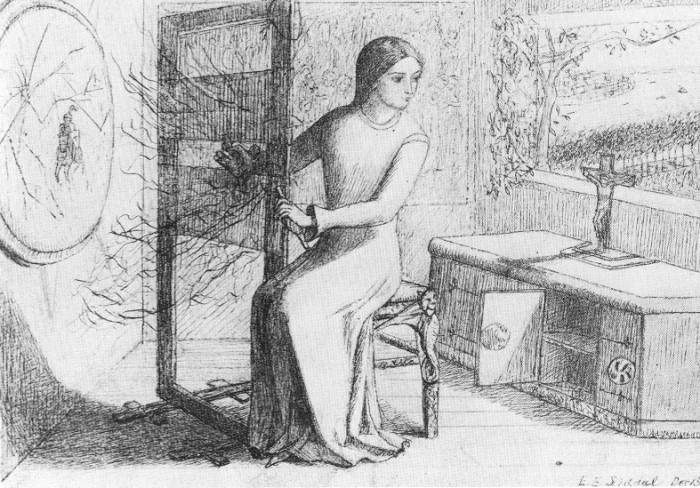She left the web, she left the loom,
She made three paces through the room,
She saw the water-lily bloom,
She saw the helmet and the plume,
She look’d down to Camelot.
Out flew the web and floated wide;
The mirror crack’d from side to side;
“The curse is come upon me,” cried
The Lady of Shalott.
— Tennyson, Lord Alfie
Chords: Am Dm C Em Am
Instrumentation: Vocals (TC-Helicon VOICELIVE), Ibanez Acoustic Guitar (AW54CE)
LYRICS
A mirror image of our age
Viewing backward toward the stage
The reverse of our course…
A worse curse?
Detached perspective of reality
Not to see how things shall be
Left alone in isolation
Ever feeling desolation
Neglecting all outside
Ignoring your inside
Where can hope reside
When feelings have died
[Bridge: the mirror cracks]
At an increasing rate
Leading to a tragic fate
What of the broader circumstance
Love, dance, and romance?
Will you let your life rot
Like the Lady of Shalott?
- The-Lady-of-Shalott-Interlude.mp3
- The-Lady-of-Shalott-Part-II.mp3
- The-Lady-of-Shalott-Part-III.mp3
- The-Lady-of-Shalott-Part-III-Instrumental.mp3
- The-Lady-of-Shalott-Harpsichord.MID
- The-Lady-of-Shalott-II-preqeul.MID
- The-Lady-of-Shalott-III-RH-Yamaha-PSR-740.MID
- The-Lady-of-Shalott-LH-Cadio-WK-3500.Z02
Chords: Am / Dm C Em Am / Am G Am / C D E; Part III Trip-Hop Epic Ballad @ 70 to 120 Beats Per Minute
Instrumentation: Vocals (TC-Helicon VOICELIVE and MiniNova Vocorder), Ibanez Acoustic Guitar (AW54CE), Keyboards (Korg PS60, Casio WK-3500, Yamaha PSR-740, MiniNova, MicroKorg)
ABOUT THE SONG (AND POEMS)
The first four of the 1842 second version of the poem describe a pastoral setting. The Lady of Shalott lives in an island castle in a river which flows to Camelot, but the local farmers know little about her.
And by the moon the reaper weary,
Piling sheaves in uplands airy,
Listening, whispers, “‘Tis the fairy
Lady of Shalott.”
Stanzas five to eight describe the lady’s life. She suffers from a mysterious curse and must continually weave images on her loom without ever looking directly out at the world. Instead, she looks into a mirror, which reflects the busy road and the people of Camelot who pass by her island.
She knows not what the curse may be,
And so she weaveth steadily,
And little other care hath she,
The Lady of Shalott.
The reflected images are described as “shadows of the world”, a metaphor that makes it clear they are a poor substitute for seeing directly (“I am half-sick of shadows”).

Stanzas nine to twelve describe “bold Sir Lancelot” as he rides by and is seen by the lady.
All in the blue unclouded weather
Thick-jewell’d shone the saddle-leather,
The helmet and the helmet-feather
Burn’d like one burning flame together,
As he rode down to Camelot.
The remaining seven stanzas describe the effect on the lady of seeing Lancelot; she stops weaving and looks out of her window toward Camelot, bringing about the curse.
Out flew the web and floated wide—
The mirror crack’d from side to side;
“The curse is come upon me,” cried
The Lady of Shalott.
She leaves her tower, finds a boat upon which she writes her name, and floats down the river to Camelot. She dies before arriving at the palace. Among the knights and ladies who see her is Lancelot, who thinks she is lovely.
“Who is this? And what is here?”
And in the lighted palace near
Died the sound of royal cheer;
And they crossed themselves for fear,
All the Knights at Camelot;
But Lancelot mused a little space
He said, “She has a lovely face;
God in his mercy lend her grace,
The Lady of Shalott.”
ABOUT The Lady of Shalott
Alfred Lord Tennyson’s four-part poem, ‘The Lady of Shalott,’ narrates the tale of a young medieval woman mysteriously confined on an island near Camelot. Her existence revolves around the solitary tasks of weaving a vibrant web and observing the outside world solely through a mirror. A curse looms over her: gazing directly at Camelot will bring about misfortune. The poem unfolds the tragic narrative of Elaine of Astolat, a young noblewoman marooned in a tower upstream from Camelot. Tennyson’s exploration of Arthurian themes is depicted as “a valid setting for the study of the artist and the perils of personal isolation,” as noted by one of his biographers.
CLIMATE CHANGE METAPHOR
The Lady of Shalott, in Alfred Lord Tennyson’s poem, can be metaphorically linked to climate change through the theme of isolation and the consequences of disregarding the world outside her confined existence. The Lady, secluded on her island and restricted to experiencing life indirectly through her mirror, represents a detached perspective on reality.
Similarly, humanity, in the context of climate change, can be seen as isolating itself from the environmental challenges that surround it. The Lady’s curse, triggered by the direct view of Camelot, symbolizes the repercussions of ignoring or neglecting the outside world. In the climate change metaphor, this could signify the adverse effects that result from turning a blind eye to environmental issues, such as rising temperatures, pollution, and loss of biodiversity.
The Lady’s curse leads to her tragic fate, emphasizing the potential dire consequences of disregarding the broader context. In the climate change metaphor, it underscores the urgency of addressing environmental concerns and the interconnectedness of human actions with the health of the planet. The Lady’s story serves as a cautionary tale, urging us to break free from isolation, acknowledge the reality of climate change, and actively engage in preserving the delicate balance of our environment.
